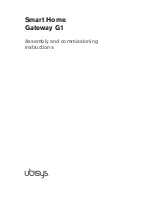
QX5
QXFXO4/QXISDN4/QXE1T1/QXFXS24; (SW Version 6.0.x)
48
QXFXO4/QXISDN4/QXE1T1/QXFXS24 Manual II: Administrator’s Guide
When
Generate Progress Tone to PSTN/PBX
checkbox is selected, QX generates ring tones to callers during ISDN call dialing. This feature is mainly
applicable to 2-stage dialing mode.
Enable CLIR Service
checkbox selection enables Calling Line Identification Restriction (CLIR) service which displays the incoming caller ID only if
Presentation Indication is allowed on the remote side. Otherwise, if CLIR service is disabled, caller ID will be unconditionally displayed.
When the
Alternative Disconnection Mode
checkbox is not selected, QX will disconnect the call as soon as the disconnect message has been received
from the peer. When the checkbox is selected, QX’s user may hear a busy tone when peer has been disconnected.
P-Asserted-Identity:
The
Disable P-Asserted-Identity
radio button disables the P-Asserted-Identity feature for both incoming and outgoing calls.
The
Override CLID with P-Asserted-Identity
radio button selection enables SIP P-Asserted-Identity support. For the calls from SIP to ISDN if Invite SIP
message contains a P-Asserted-Identity, then the CallerID on ISDN is sent with the original Caller ID, which comes from the identity field. SIP user agent
should check for the existence of the P-Asserted-Identity, then the P-Preferred-Identity, then the Remote-Party-ID to fill the identity field.
For the calls from ISDN to SIP with restricted Caller ID, the SIP Invite message contains P-Asserted-Identity field with the value from the Caller ID on ISDN.
The SIP From field contains “anonymous”.
The
Use Redirecting Number Info Element with P-Asserted-Identity
radio button selection enables full support of the SIP P-Asserted-Identity.
For the calls from SIP to ISDN, if the SIP Invite message contains a P-Asserted-Identity or a P-Preferred-Identity or a Remote-Party-ID, then the CallerID on
ISDN contains the number from the user name field and the Redirecting Number IE contains the original number from the identity field. SIP user agent
should check for the existence of the P-Asserted-Identity, then the P-Preferred-Identity, then the Remote-Party-ID to fill the identity field.
For the calls from ISDN to SIP with Caller ID, the SIP Invite message contains P-Asserted-Identity field with the original number value from the Redirecting
Number IE on ISDN. The SIP From field contains the value from the user name.
When the
Send Calling Party Subaddress
checkbox is selected, QX will send the extension number as subaddress and the value defined in the
Default
outgoing Caller ID
field as caller ID on the outgoing call. When this checkbox is disabled, no subaddress information will be sent and the caller ID will be
defined according to the selection of the
Use Default Outgoing Caller ID
checkbox (see above). Caller ID information, along with the Subaddress, can be
displayed on the phone display depending on the phone and PBX settings and capabilities.
When the
Ignore Empty Channel Identification in CALL PROCEEDING Msg.
option is selected, QX will ignore the empty ISDN L3 Channel Identification
information element in CALL PROCEEDING message and will not response with STATUS message.
When this checkbox is disabled, QX will response with STATUS message on empty Channel Identification information element.
The
B1 Channel
and
B2 Channel
checkboxes enables/disables timeslots for voice transfer. Disabling the timeslot will prevent both incoming and
outgoing calls.
Clicking on the
ISDN Stats
link will open the
ISDN Status
page that displays ISDN traffic statistics on the corresponding ISDN trunk. The
ISDN Stats
link is
displayed for every active trunk on the board and refers to the page where ISDN trunk and traffic statistics can be viewed.
















































